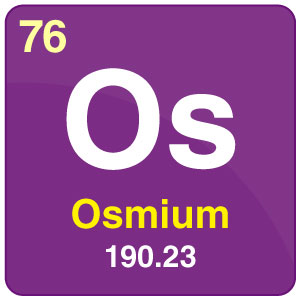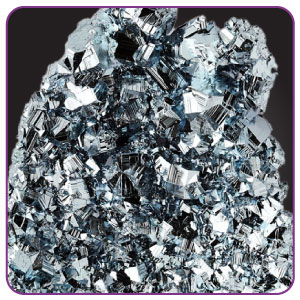Osmium (Os)

| Symbol | Os |
| Atomic Number | 76 |
| Atomic Mass | 190.2 g.mol -1 |
| Discovered by | Smithson Tennant in 1803 |

Chemical Properties of Osmium
| Group | 8 | Melting point | 3045 °C |
| Period | 6 | Boiling point | 5027 °C |
| Block | d | Density (g cm−3) | 22.5872 |
| Atomic number | 76 | Relative atomic mass | 190.23 |
| State at 20°C | Solid | Key isotopes | 192Os |
| Electron configuration | [Xe]4f14 5d6 6s2 | CAS number | 7440-04-2 |
| ChemSpider ID | 22379 | ChemSpider is a free chemical structure database |
What is Osmium?
- Osmium is a lustrous and silvery metal with an atomic number of 76 in the periodic table.
- It tends to be a dense metal. It appears like a bluish metal that occurs in the group Platinum.
Uses of Osmium
- It is employed in industries as a catalyst.
- It also has a great use in the field of space applications because of its high reflectivity.
- It is used in light bulbs and incandescent lamps to increase the light output.
- Osmium tetroxide is being used in fingerprint detection.
- It is used as an electrolyte in the battery applications as it can absorb hydrogen atoms.
- It is used in fountain pen tips.
Properties of Osmium
- The metal is neither affected by acid or by water but tends to dissolve in molten alkalis.
- It is a naturally occurring element and it can also be obtained by commercial means during the refining of nickel.
- At high temperatures, the metal turns lustrous, hard and brittle.
Certain Facts About Osmium
- Osmium was first discovered in the year 1803 by William Hyde Wollaston and Smithson Tennant in England.
- Osmiridium and iridosmine are the ores of osmium and this metal is rarely found in some parts of North America, South America, and also in Russia.
Frequently Asked Questions – FAQs
Q1
Write the electronic configuration of Osmium.
The electronic configuration of Osmium is [Xe]4f14 5d6 6s2 and its atomic number is 76.
Q2
Why Osmium is called a d-block element?
The electronic configuration of Osmium is [Xe]4f14 5d6 6s2 and the last electron of Osmium enters the d subshell. so it is called a d-block element.
Q3
What are the properties of Osmium?
The atomic mass of Osmium is 190.2 g/mol, its melting point is 3045°C and its density is 22.5872 grams per cubic centimetre.
Q4
What are the uses of Osmium?
It is employed in industries as a catalyst. It also has a great use in the field of space applications because of its high reflectivity. It is used in light bulbs and incandescent lamps to increase the light output.
Q5
How many elements are there in the periodic table?
118 Elements are present in the Periodic Table.


Comments